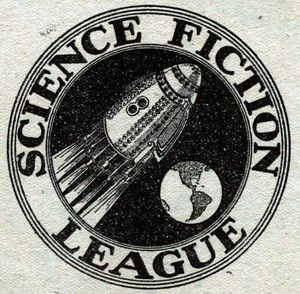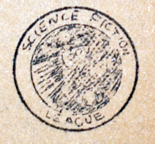Difference between revisions of "Science Fiction League"
| Line 2: | Line 2: | ||
The community of [[fandom]] arguably began with the '''Science Fiction League''', probably the single most important [[fan]] [[organization]] of the 1930s. The '''SFL''' was a commercially sponsored [[club]] for [[stf]] [[readers]], but through it, the first [[protofans]] met each other and came into a sense of group self awareness. | The community of [[fandom]] arguably began with the '''Science Fiction League''', probably the single most important [[fan]] [[organization]] of the 1930s. The '''SFL''' was a commercially sponsored [[club]] for [[stf]] [[readers]], but through it, the first [[protofans]] met each other and came into a sense of group self awareness. | ||
| − | [[Hugo Gernsback]] promoted the international [[club]] as a way to drum up readership for his second [[pulp]] [[prozine]], ''[[Wonder Stories]]'', and fill its pages without having to pay writers. The idea seems to have come from [[Charles D. Hornig]] who had been picked from the readership ranks to become the 17-year-old [[editor]] of ''Wonder Stories'', who announced the club in the May 1934 issue. It offered fans, via ''Wonder Stories''' pages, chartered membership certificates for SFL local branches, lapel buttons and club stationery, and [[letter columns]] in the magazine printed the letter writers names and addresses, allowing them to get in contact with each other and create fandom. (The first local club, the [[Scienceers]], got together as a result.) | + | [[Hugo Gernsback]] promoted the international [[club]] as a way to drum up readership for his second [[pulp]] [[prozine]], ''[[Wonder Stories]]'', and fill its pages without having to pay writers. The idea seems to have come from [[Charles D. Hornig]] who had been picked from the readership ranks to become the 17-year-old [[editor]] of ''Wonder Stories'', who announced the club in the [https://archive.org/details/Wonder_Stories_v05n10_1934-05 May 1934 issue]. It offered fans, via ''Wonder Stories''' pages, chartered membership certificates for SFL local branches, lapel buttons and club stationery, and [[letter columns]] in the magazine printed the letter writers names and addresses, allowing them to get in contact with each other and create fandom. (The first local club, the [[Scienceers]], got together as a result.) |
| − | Interestingly, Gernsback announced the SFL as "a non-commercial membership organization for the furtherance and betterment of the art of science fiction." It was not noticed at the time, but by founding a club devoted to ''stf'', he effectively gave up his idea that sf existed to promote science | + | Interestingly, Gernsback announced the SFL as "a non-commercial membership organization for the furtherance and betterment of the art of science fiction." It was not noticed at the time, but by founding a club devoted to ''stf'', he effectively gave up his idea that sf existed to promote science. |
An imposing (but powerless) list of “Executive Directors,” prominent [[fen]] (meaning, at the time, prolific writers to the [[prozine]] [[letter columns]]) and [[pro]]s: [[Forrest J. Ackerman]], [[Eando Binder]], [[Jack Darrow]], [[Edmond Hamilton]], [[David H. Keller]], M.D., [[P. Schuyler Miller]], [[Clark Ashton Smith]], and [[R. F. Starzl]]. [[Hugo Gernsback]] himself was Executive [[Secretary]], [[Charles D. Hornig]], Assistant Secretary. Members were supposed to propagandize [[stf]] and promote it by "personal solicitation" (i.e. a peptalk) whenever they could buttonhole a victim. The SFL department of ''Wonder Stories'' reported activities of [[locals]] and of [[fandom]] in general, announced proposed new locals, listed new members and addresses. [[George Gordon Clark]] of [[Brooklyn]] was member #1. | An imposing (but powerless) list of “Executive Directors,” prominent [[fen]] (meaning, at the time, prolific writers to the [[prozine]] [[letter columns]]) and [[pro]]s: [[Forrest J. Ackerman]], [[Eando Binder]], [[Jack Darrow]], [[Edmond Hamilton]], [[David H. Keller]], M.D., [[P. Schuyler Miller]], [[Clark Ashton Smith]], and [[R. F. Starzl]]. [[Hugo Gernsback]] himself was Executive [[Secretary]], [[Charles D. Hornig]], Assistant Secretary. Members were supposed to propagandize [[stf]] and promote it by "personal solicitation" (i.e. a peptalk) whenever they could buttonhole a victim. The SFL department of ''Wonder Stories'' reported activities of [[locals]] and of [[fandom]] in general, announced proposed new locals, listed new members and addresses. [[George Gordon Clark]] of [[Brooklyn]] was member #1. | ||
Revision as of 15:00, 3 September 2021
The community of fandom arguably began with the Science Fiction League, probably the single most important fan organization of the 1930s. The SFL was a commercially sponsored club for stf readers, but through it, the first protofans met each other and came into a sense of group self awareness.
Hugo Gernsback promoted the international club as a way to drum up readership for his second pulp prozine, Wonder Stories, and fill its pages without having to pay writers. The idea seems to have come from Charles D. Hornig who had been picked from the readership ranks to become the 17-year-old editor of Wonder Stories, who announced the club in the May 1934 issue. It offered fans, via Wonder Stories' pages, chartered membership certificates for SFL local branches, lapel buttons and club stationery, and letter columns in the magazine printed the letter writers names and addresses, allowing them to get in contact with each other and create fandom. (The first local club, the Scienceers, got together as a result.)
Interestingly, Gernsback announced the SFL as "a non-commercial membership organization for the furtherance and betterment of the art of science fiction." It was not noticed at the time, but by founding a club devoted to stf, he effectively gave up his idea that sf existed to promote science.
An imposing (but powerless) list of “Executive Directors,” prominent fen (meaning, at the time, prolific writers to the prozine letter columns) and pros: Forrest J. Ackerman, Eando Binder, Jack Darrow, Edmond Hamilton, David H. Keller, M.D., P. Schuyler Miller, Clark Ashton Smith, and R. F. Starzl. Hugo Gernsback himself was Executive Secretary, Charles D. Hornig, Assistant Secretary. Members were supposed to propagandize stf and promote it by "personal solicitation" (i.e. a peptalk) whenever they could buttonhole a victim. The SFL department of Wonder Stories reported activities of locals and of fandom in general, announced proposed new locals, listed new members and addresses. George Gordon Clark of Brooklyn was member #1.
Enthusiastic readers poured like gnurrs from the voodvork out to join up, and SFL chapters popped up wherever Wonder Stories was distributed – New York, Chicago, Los Angeles, Philadelphia, Lincoln, Lewiston, Maine, even Leeds in England.
When Gernsback suffered one of his periodic financial crises in 1936, legal control of the SFL passed to Standard Publications, which let it die of neglect. Many chapters severed all ties with the SFL, some collapsed entirely, but two (after renaming themselves) continue to meet regularly to the present day – the ones in Los Angeles (now LASFS) and Philadelphia (now PSFS). In any event, by that point the League was no longer needed – fandom was up and running, self-perpetuating and a thing alive.
The Los Angeles Science Fantasy Society (LASFS) started out as the Los Angeles Science Fiction League (LASFL), one of the chartered clubs under the Gernsback SFL umbrella. Arguably the oldest regularly meeting sf club in the U.S., it was chapter 4 of the League, while the Philadelphia SFL (its only possible rival) was chapter 11. The Philadelphia club withdrew from the League in the 1930s and substituted "Society" for "League" in their name, becoming PSFS. The LASFL substituted "Society" for "League" when the Science Fiction League ceased to be a sponsoring organization and "Fantasy" for "Fiction" to expand their area of appeal.
In an amusing hoax, George Scithers fooled LASFS in 1980 over a refounded SFL. See Scithers SFL Hoax.
- Science Fiction League history by Doc Lowndes in Outworlds 49 (April 1987, p. 1620).
Chapters:[edit]
| From Fancyclopedia 2, ca. 1959 |
| from SFL Fancyclopedia 2 ca. 1959
The Science Fiction League, launched in 1934 by Gernsback and Hornig, sponsored by Wonder Stories. An imposing (but powerless) board of directors included prominent fen like Ackerman. Members got insignia and stationery 'n stuff blazoned with the group's emblem (illustrated on the Fan-Dango Award); they were supposed to propagandize stf (little stickers were planned for the purpose) and promote it by "personal solicitation" (i.e. a peptalk) whenever they could buttonhole a victim. The SFL department of Wonder Stories reported activities of locals and of fandom in general, announced proposed new locals, listed new members and addresses, and carried the Science-Fiction Tests. Under TWS the League was continued, but more commercialized, and the department was often used to blurb future issues. In the course of time the League enrolled several thousand readers, tho most of these never did anything more than send in their names, and some were duplicate enrollments or pen-names. It was hoped that the SFL could become the general fan organization, but this was dashed when non-payment of young authors (the fault of a department of the company not under Hornig's control) and natural rivalry brought on the ISA-SFL war and the expulsion of Wollheim, Sykora, and Michel. The chief importance of the SFL in fandom was in the chapters that were set up, of which the most important were LASFL, QSFL, GNYSFL, Leeds SFL and other locals with different names, like the PSFS. In these titles by "SFL" we understand "chapter of the SFL". By the rules only one chapter could be established in a city, except in cities over 1,000,000. Three members were required for setting up a chapter; most such three-man chapters were short-lived. A rule which soon lapsed made the chapter-member with the lowest serial number Director. Of other rules there were few; one was that members promise to answer with reasonable promptness all (non-commercial) correspondence addressed to them as members. The organization was moribund before the end of 1941. |
| From Fancyclopedia 1, ca. 1944 |
|
from SFL Fancyclopedia 1 ca. 1944 The Science Fiction League, launched in 1934 by Gernsback and Hornig, sponsored by Wonder Stories. An imposing Board of Directors included Ackerman and Darrow, but they had no power. The SFL department of Wonder Stories reported activities of locals and of fandom in general, announced proposed new locals, listed new members and addresses, and carried the B Stf test and results. Under TWS the League was continued, but more commercialized, the department often being used to blurb future issues. In course of time the League enrolled several thousand members, tho most of these never did anything more than send in their names, and some of the memberships are duplicate enrollments or things like Peggy Gillespie. It was hoped that the SFL could become the general fan organization, but this was dashed when non-payment of young authors (it should be added that this was up to a department of the company not under Hornig's control) and natural rivalry brot on the ISA-SFL war and the expulsion of Wollheim, Sykora, and Michel. In those cases, "SFL means "chapter of the SFL". Only one chapter can be established in the same city, except in cities over 1,000,000. Three members are required for setting up a chapter; most such three-man organizations are quite short-lived. There is an old rule, no longer observed, that the member with the lowest serial number shall be director. Of other rules there were few; one was that members promise to answer with reasonable promptness all (non-commercial) correspondence addressed to them as members. The emblem was reproduced on lapel buttons and stationery which were for sale. |
| Club |
| This is a club page. Please extend it by adding information about when and where the club met, when and by whom it was founded, how long it was active, notable accomplishments, well-known members, clubzines, any conventions it ran, external links to the club's website, other club pages, etc.
When there's a floreat (Fl.), this indicates the time or times for which we have found evidence that the club existed. This is probably not going to represent the club's full lifetime, so please update it if you can! |

